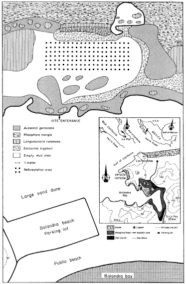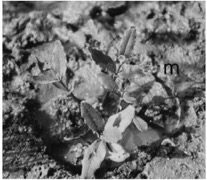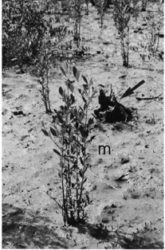Overview
Black mangrove (Avicennia germinans) seedlings (n=555) were grown from field-collected propagules for several months in a new type of terrestrial nursery. They were grouped in clusters of five plants and then transplanted to a clear-cut zone at Laguna de Balandra, a lagoon fringed by mangrove forest in Baja California Sur, Mexico. The survival rates and development of the transplanted seedlings were monitored at 6-month intervals for 2 years. After 1 month, the survival of seedlings was 96%, and after 24 months, 74% of the plants were still alive. Due to the slow rate of natural regeneration observed at the lagoon, and the proven susceptibility of directly-sown propagules to high salinity levels in these arid-zone mangroves, the success of this initial transplantation bodes well for the eventual restoration of arid coastal lagoons and estuaries using nursery-reared seedlings.
Quick Facts
Project Location:
24.3195291, -110.3177977
Geographic Region:
Latin America
Country or Territory:
Mexico
Biome:
Coastal/Marine
Ecosystem:
Estuaries, Marshes & Mangroves
Area being restored:
0.4 acres
Organization Type:
University / Academic Institution
Location
Project Stage:
Completed
Start Date:
1994-08-05
End Date:
1996-12-05
Primary Causes of Degradation
Deforestation, Mining & Resource ExtractionDegradation Description
All the white and black mangrove trees at the project site had been poached for firewood in 1991, leaving a barren, flat, muddy tidal area of about 1500m2. The clearcut area was naturally regenerated from 1991 to 1996 at a very slow rate and was partially covered at its edges by annual salicornia plants (Salicornia bigelouii Torr.).
Project Goals
The aims of this study were: (i) to develop a simple and inexpensive nursery method for producing seedlings for the reforestation of mangrove swamps in an arid zone, (ii) to monitor the development of such plants under natural conditions, and (iii) to compare the efficiency of artificial reforestation to natural regeneration in an arid-zone mangrove ecosystem.
Monitoring
The project does not have a monitoring plan.
Description of Project Activities:
Black mangrove propagules (Avicennia germinans (L.) Stern) were collected from the same location at Laguna de Balandra described in a previous study (Toledo et al., 1995). Propagules (4 cm long) were picked directly from the trees in August 1994, transferred to the laboratory and examined. Those with small insect holes were discarded. Propagules were washed and disinfected as previously described (Toledo et al., 1995). Because our previous nursery techniques failed, only one nursery method was evaluated in this study.
White sand was collected from a beach in Laguna de Balandra, sieved (1 mm mesh), and washed 10 - 12 times with pressurized salty tap water (2560 μmhos cm−1) until the discarded supernatant was completely clear. Sand (approx. 800 g) was then loosely packed into cylindrical, 900-ml plastic biodegradable bags. Each bag was supplemented once with the mineral salt solution of Murashige & Skoog (1962) medium. The bags did not have a drainage hole. The volume of the solution in the bags was adjusted to maintain approximately 3 mm of water over the sand surface at all times. To prevent potentially damaging salt accumulation (which at high concentration might inhibit seedling growth or cause death (Cintrón et al., 1980)) in the nursery bags due to high evaporation rates, seedlings were watered daily with desalinized water (325 μmhos cm−1; equi. 0.2 g salts l−1) to the required water level above the sand surface. The total accumulation of salt during the entire growth period did not exceed salt concentration in seawater (33 g l−1 salts). As this is a critical step of the nursery procedure, the salt level was routinely verified by conductivity measurements.
Five propagules were planted in each bag, 1 - 2 cm apart, on the sand surface, and incubated indoors at a light intensity of 200 μmole m−2 s−1 for 1 week at 25+3 ºC. Once the propagules developed a few roots, they were transferred outdoors and incubation continued in a shaded (<3 h direct sunlight per day), outdoor nursery for 90 d. The average ambient day:night temperatures were 37, 34 and 30 ºC and 24, 20 and 19 ºC in September, October and November 1994. The relative humidity was 25 - 40% with no rain and no strong winds during this period. Light intensity ranged from 116 in the shade to 1622 μmole m−2 s−1 in full sun. Because information available before this study indicated high seedling mortality after transplantation in the arid zone lagoon, researchers decided to introduce the nursery seedlings in clusters, to achieve a meaningful plant population. Only bags containing 5 developed seedlings each (approx. 10 cm high with 4 - 6 leaves each) were transferred to the mangrove swamp.
Nursery-reared black mangrove seedlings (555 plants in 111 bagged clusters) were transferred to Laguna de Balandra in December 1994. They were planted during one morning at low tide in their plastic bags (to avoid damage to the root system and to reduce the shock due to an abrupt change in their growth environment) in holes dug with a hole digger. Five to six long cuts were made in each bag from the top to the bottom. The cuts did not directly expose the roots to the environment. The roots emerged from the bags only after an additional growing period and biodegradation of the bags. The distance from one cluster to another was 1±0.20 m as recommended for Avicennia transplantation in other ecosystems (Teas, 1977). The few natural mangrove seedlings in the study area were left in place, reducing the distances between clusters. In no case was a cluster planted <60 cm from a volunteer plant. To distinguish transplanting from natural regeneration, all transplants were arranged in a grid plot with marked borders. Also, no seedlings were planted close to the existing forest, since this increases seedling mortality (Aksornkoae, 1981 cited in Aksornkoae et al., 1984). Although the reforestation zone was near a popular beach, it was protected from vandalism by a soft, deep natural mud barrier which denied access, and by warning signs. After planting, the reforestation area was not further treated. Plant survival was monitored initially 1, 2 and 4 weeks after planting and every 6 months thereafter. Data on plant height, number of leaves and survival rates were collected.
Ecological Outcomes Achieved
Eliminate existing threats to the ecosystem:
The propagule vigor of black mangroves collected from the wild was high; the survival of propagules in the nursery for the initial 3 months was 100%. A small number of propagules (<5%) developed relatively small seedlings (1 - 2 leaves, <10 cm height) and were discarded. The seedlings growing in the nursery showed no disease symptoms. Biocides were, therefore, not used.
Plant population histograms drawn from measurements taken during 2 years in the reforestation area revealed that plant heights followed a normal distribution pattern in most sampling periods. Average seedling heights were 13, 31, 46 and 62 cm, after 6, 12, 18 and 24 months. The tallest plants were 24 cm (after 6 months), 63 cm (after 12 months), 90 cm (after 18 months), and 120 cm (after 24 months).
The number of leaves per plant did not follow a normal distribution. The average number of leaves per plant was 10, 32, 48 and 178 after 6, 12, 18 and 24 months, with the largest number of leaves of 22 (after 6 months), 56 (after 12 months), 118 (after 18 months) and 432 (after 24 months). There was a significant linear correlation between plant height and the number of leaves.
Weekly visits after transplantation of the seedlings to the swamp revealed that after 4 weeks 96% of all plants survived. Later, the survival rate declined and was 86% (6 months), 77% (1.0 and 1.5 years). After 2 years, 74% of all original seedlings were alive, and all were still growing after 4 years.
All nursery clusters used for reforestation were originally planted in the swamp with 5 seedlings per cluster. With time, the number of the plants in each cluster declined, forming clusters with 1 - 5 plants. The number of clusters with different plant densities varied from 140 clusters with 5 plants to only 6 clusters with one plant.
Because naturally established seedlings were not removed from the study zone, the annual rate of natural regeneration could be monitored. Except for 1995, when 25 white mangrove plants were established, the natural regeneration was slow and consisted of 8 plants per year per 350 m2 of swamp. The slowest natural regeneration was exhibited by red mangroves, with only a single plant established in 6 years.
Factors limiting recovery of the ecosystem:
In many tropical areas, mangroves are able to regenerate, given sufficient recovery time (Aksornkoae et al., 1984). However, in dry zones with little tidal flux, mangroves regenerate poorly after clear-cutting. For example, in Bahia de La Paz, Baja California Sur, Mexico, hardly any survive in spite of the fact that many seedlings germinate naturally by the end of the propagule season (Bashan, 1999 unpublished). Six years after the clear-cut in Laguna de Balandra, only 48 new seedlings were found per 350 m2. The cause for this low rate of natural reforestation and the limited development of mangroves in arid zones was attributed by Cintrón et al. (1980) to a high rate of evaporation without compensation by fresh water and thus, a high level of soil salinity. Although mangroves are basically tolerant of high salt levels and low oxygen levels, very high salinity results in sparse vegetation, small, slender trees, and eventually a high mortality rate for both seedlings and trees (Cintrón et al., 1978, 1980; Jintana et al., 1992).
Socio-Economic & Community Outcomes Achieved
Economic vitality and local livelihoods:
Because they are an important refuge and feeding ground for numerous economically important fish and shellfish species, mangrove forests are indispensable for sustainable coastal fisheries. Therefore, this and other mangrove reforestation projects will benefit local livelihoods by ensuring the continued vitality of a valuable ecosystem.
Key Lessons Learned
Direct sowing of mangrove propagules (as practiced in Southeast Asia) in these dry-climate ecosystems is usually unsuccessful. Although seedlings may initially be established successfully, most eventually die within a few months. Research experience has thus far shown that propagules grown under controlled conditions in growth chambers cannot withstand the stress of transfer to the harsh environmental conditions of Baja California Sur (Toledo, 1994, unpublished). Furthermore, previous attempts to create a nursery in pots submerged in the tidal zone, or to use tissue-culture seedlings, have also been disappointing (Holguin et al., 1991, unpublished). Therefore, development of an outdoor nursery system that would function independent of tides was needed to overcome the salt-stress susceptibility of seedlings when transplanted. The wood of red mangroves is preferred commercially, and most of the Pacific coast of Central America is colonized by this species (Jiménez, 1988), but black mangroves were chosen as a model for this study due to the availability of propagules and their compact size–making them easier to transplant as seedlings (Carlton, 1974; Teas, 1977).
Because the survival rate of seedlings in the terrestrial nursery was very high, the development of trees after transplantation to their natural environment was monitored for 2 years without special tending, and survival rates were monitored for 4 years. The data on seedling survival in the wild are varied. High survival rates in Southeast Asia have been reported, while survival rates elsewhere are often lower (Rabinowitz, 1978; Aksornkoae et al., 1984; Patterson et al., 1993). Information on the survival of mangrove seedlings in arid zones is scarce (Cintrón et al., 1978), but rates of regeneration are generally low. The nursery system developed for this project, besides confirming the possibility of producing nursery-reared black mangrove seedlings, also demonstrated that these seedlings will survive well after transplantation in arid-zone mangroves, improving the feasibility of reforesting mangroves in areas where natural regeneration is slow.
Sources and Amounts of Funding
This study was supported in part by grants #28362 B and #26262 B from Consejo Nacional de Ciencia y Tecnología (CONACyT), México and by the Bashan Foundation. GT was partially supported by grants No. 83916 from Consejo Nacional de Ciencia y Tecnología (CONACyT) and No. 930108 from Instituto Politécnico Nacional. Centro Interdisciplinario de Ciencias Marinas, Programa Institucional de Formación de Investigadores (CICIMAR-PIFI) (Mexico).
Other Resources
Giani, L. et al., 1996. Characteristics and methanogenesis of the Balandra lagoon mangrove soils, Baja California Sur, Mexico. Geoderma 72: 149-160.
Toledo, Gerardo et al., 2001. Monitoring of black mangrove restoration with nursery-reared seedlings on an arid coastal lagoon. Hydrobiologia 444: 101-109.
Toledo, Gerardo et al., 1995. Cyanobacteria and black mangroves in Northwestern Mexico: colonization, and diurnal and seasonal nitrogen fixation on aerial roots. Canadian Journal of Microbiology 41(10): 999-1011.
Yoav Bashan
E-mail: [email protected]




